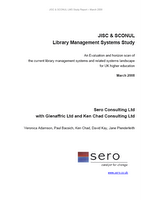A "Vision for Development" -- Excerpt from the JISC/SCONUL Study
As our profession re-examines itself and the services we provide to users, we seem to spend a great deal of time concerned about the way our "web front door" looks and operates. That is, we expect web users to come through the front page of our website and so we agonize over the features as well as the look-and-feel of our portal of information. A section of the JISC & SCONUL Library Management Systems Study ((Adamson, V., Bacsich, P., Chad, K., Kay, D., & Plenderleith, J. (2008). JISC & SCONUL Library Management Systems Study. 156 p. Retrieved April 17, 2008, from http://www.jisc.ac.uk/media/documents/programmes/resourcediscovery/lmsstudy.pdf.)) released last month suggests a different path for our information environment: one where the content is not bound to the confines of our web portals. This is the first in a series of posts over the next few days and/or weeks that explore this and other observations and commentary found in the JISC/SCONUL report.
 The title of section 3.6 of the report is "Visions for Development ('a place in both worlds?')". It spans pages 39 and 40 of the report and is a peek at a library content world unbounded by portals and websites that act and function only as backwater destination sites. I've pulled together and reordered various sentences from these two pages that, while I hope remain true to the authors' original intent, summarize this critical shift in mindset that we should consider adopting:
The title of section 3.6 of the report is "Visions for Development ('a place in both worlds?')". It spans pages 39 and 40 of the report and is a peek at a library content world unbounded by portals and websites that act and function only as backwater destination sites. I've pulled together and reordered various sentences from these two pages that, while I hope remain true to the authors' original intent, summarize this critical shift in mindset that we should consider adopting:
Rather than creating their own online one-stop-shops using environments created by library system suppliers, libraries really need to surface their resources in the online environments already inhabited by their users. We cannot expect users to come to us, but should rather design systems that can go out to them. Such an approach implies a more open architecture using standards and protocols to be able to move structured information around so that it can be presented in other places. The result will be opportunity for fusion (perhaps synergy is a helpful alternative) -- exploiting canonical data by re-purposing, remixing or mashing it up. Whilst the use of Google Maps is the most common mash-up example, it is no coincidence that remixes and mash-ups originate in the music industry, which passed ahead of others down the path of financial and intellectual deconstruction and reconstruction in the digital age. The challenge is whether academic libraries are well placed and agile enough to facilitate their users in exposing and re-mixing content.
It seems like quite a number of such reports have been released over the past year. (Lorcan Dempsey points to another one from the University of Wisconsin, Madison just earlier this month.) There is some U.K.-specific discussion in the JISC/SCONUL report, but there is also a lot that applies to libraries in North America as well. I highly recommend sitting down with a copy.